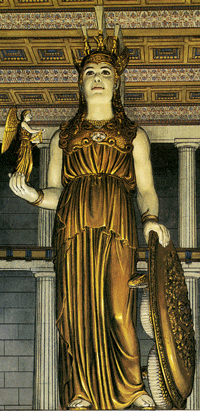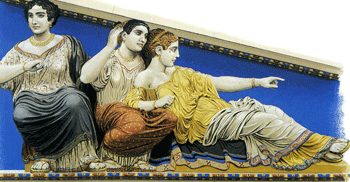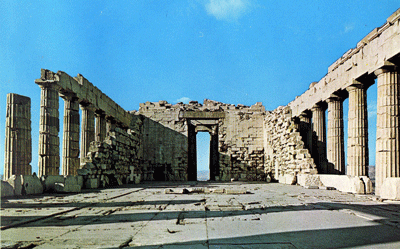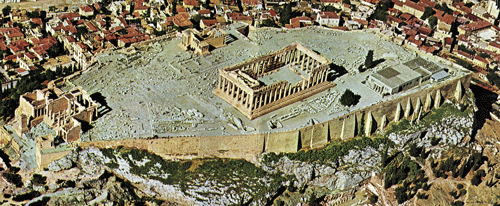|
Why was it built?
The Greeks fought a war
against the Persians from 490BC to 479BC. They finally defeated them but the
Persians destroyed the Acropolis in 480BC. |
The Athenians had to
rebuild the temple to Athena that had been ruined.
They also wanted to
celebrate the victory over the Persians, and to give thanks to Athena,
goddess of war, who they believed had helped them win the battles. |
The Athenians had also
found a rich seam of silver in Laurium which gave them the money to build a
magnificent temple. |
|
What was the Parthenon used for?
Most people have always
thought the Parthenon was a temple to the goddess Athena. The building has
the shape of a Doric temple, and there was a statue of Athena inside.
Athena was the patron goddess of Athens, and the city was named after her.
‘Parthenon’ comes from Athena Parthenos, which means Athena the virgin. |
 |
Sacrifices were made to
Athena here, and every four years there was a big festival to Athena which
ended at the Parthenon (see later, the Panathenaic festival).
Some people, however, think
that the Parthenon was really a treasury. A lot of gold treasure was stored
here in a room at the back of the temple, and there was 1000kg of gold on the
statue itself (see picture). |
|
What was the Panathenaic Festival?
Every four years the
Athenians had a big celebration in honour of Athena. There were athletic
games and competitions of music, poetry, and dancing. It lasted from 28 June
to 28 July. |

Part of the Parthenon
frieze, showing the procession. |
Athenian girls spent 9 months weaving a ‘peplos’, a dress for the statue.
There was a procession which began outside the city gates and went through
the agora, up to the Acropolis, and ended at the Parthenon. Animals like
oxen and sheep were sacrificed in Athena’s honour. |
|
How big was the Parthenon?
The base of the Parthenon
is 72.5mX34m. The columns are 10.43m high and 1.9m wide at the base. There are 8 columns at the front
and back, and 17 along the sides, making 46 columns in all.
This picture shows the east
side of the Parthenon, which is the front (the right side on the picture
above). |
 |
|
How was the Parthenon built?
The Parthenon was built
with high quality marble from nearby Mt Pentelicon. The columns go all
around the cella. The cella had three rooms, but not much of these is left
today. The cella was built first, and the columns around it. |
 |
The Parthenon was very
carefully built, by expert masons. Some machinery was needed to put the very
heavy stone blocks in place. A crane such as that shown here may have been
used, and the blocks also had bits sticking out to be used for carrying. |
|
What’s so special about the Parthenon?
The Parthenon is a marvel
of architecture. The designers made many corrections, or ‘refinements’, to
make the building as beautiful as possible. For example, a long horizontal
line seems to sag in the middle. Therefore the base of the Parthenon curves
up slightly in the middle, so it doesn’t seem to sag. |

The base bulges up
6cm in
the middle (East face). |
Can you see the curve in
this picture?
For the same reason the
columns bulge out 2cm. This is called ‘entasis’. Also the columns at the
corners are the only ones which you can see in silhouette against the sky.
This makes them seem thinner, and so they were made thicker to counter this
effect. |
|
The Parthenon Sculptures
Another reason the
Parthenon is special is the wonderful sculptures it was covered with. There
were 92 metopes which were all carved, as well as the pediments and the
frieze on the outside of the cella.
This picture shows part of
the east pediment as it is today, in the British Museum, and how it would
have looked with the original paint. |

 |
All the
sculptures were originally painted with a blue background, and
reddish-brown, white, yellow, black, and grey.
In January 2006 I visited
the British Museum and took some pictures
of the Parthenon sculptures. The Greek government wants Britain to give
them back. Do you think we should?
|
|
The Pediments
Most of the sculptures on
the pediments are missing, but from descriptions by an ancient Greek
traveller, Pausanias, we know what was on them. |

West Pediment: the contest
between Athena and Poseidon to be patron of the city. Athena makes the first
olive tree grow; Poseidon makes salt water flow from the ground. |
|
These pictures show a
reconstruction of the pediments in the Acropolis Museum. |

East Pediment: the birth of
Athena. Hephaestus strikes Zeus’ head with an axe, and Athena leaps out,
fully grown, with her helmet, spear and shield. |
|
The Metopes
There are 92 metopes which
are all carved. Some are still on the building, some are in the Acropolis
Museum, some are in the British Museum and some are in the Louvre in Paris.
The subjects are all from Greek mythology, as follows:
|


South wall – the
battle of the Lapiths and the centaurs |
North wall –- Greeks
fighting Trojans
East wall – the
battle of the gods versus the giants
West wall – The
Greeks fighting the Amazons (warrior women) |
|
The Frieze
The frieze ran around the
top of outside of the cella wall – so it was actually quite hard to see. It
showed the Panathenaic procession, with horse riders, women bearing ritual
objects, men driving cows and sheep, and finally the gods themselves.
Most of the frieze is in
the British Museum and the Acropolis Museum. |

A reconstruction of part of
the frieze, showing the original colours |
|
What happened to the Parthenon?
The Parthenon was used by
the Greeks for centuries, but in the 300s AD pagan religion was banned when
Christianity became the official religion of the Roman Empire. In the Middle
Ages it was used as a church of the Virgin Mary, and later it became a
mosque, when the Turks ruled Athens.
|

inside the Parthenon
|
In 1687 the Parthenon was
being used by the Turks as an arsenal – so it was full of barrels of
gunpowder. The Venetians bombarded it with cannon fire, and BOOM! – the
middle and the roof were blown up. That’s why it is in such a state today.
The Greek government is doing what it can to restore the Parthenon, but this
will take many more years to finish. |
|
Right is a model of the Parthenon in the British Museum |
 |
|
|















